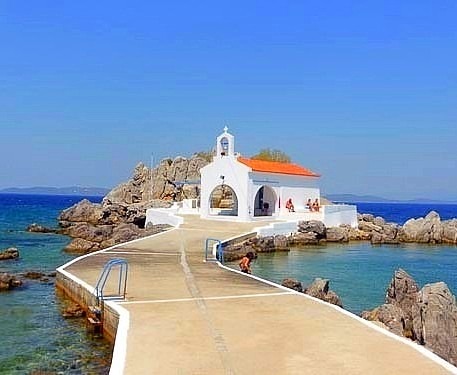Sights
Chios, being the fifth largest island in Greece, has several things to see. So I will mention some of the main sights of Chios, to give you a little taste of the endless beauty of this frontier Greek paradise.
Chios, the capital of the island
It is a fairly large town with about 25,000 inhabitants. In the city there are several departments of the University of the Aegean. In Chios you will find several places of interest such as the Municipal Library "Adamantios Korais", the castle, the Ottoman baths, the Naval Museum and the Byzantine Museum.
The Municipal Library "Adamantios Korais" housed in a building jewel for the island and is one of the largest and most remarkable libraries of Greece.
On the north side of the harbour is the castle, which occupies an area of 180,000 square meters. The main entrance is Porta Maggiore, on the south side of the fortress. Within the walls today live 650 people. Strolling around the castle you will see bastions, mosque, picturesque alleys, excellent stone buildings and the famous Ottoman baths.
If you'd like to take a leisurely stroll around the city, a good choice is the seaside pedestrian road. But if you want to stroll around the shops, choose Aplotaria, the main pedestrian street with several shops, cafés and restaurants.
Anavatos
The medieval village of Anavatos is about 20 kilometres from the town of Chios and stands at an altitude of 400 meters. The "Mystras" of the Aegean, as they call it, has a huge historical and architectural interest. The village today is uninhabited, as most residents were slaughtered in 1822 by the Turks and the big earthquake of 1881 caused significant damage to buildings.
Mastichochoria
The history of the Mastic villages begins in the Middle Ages and specifically by the conquest of the island by the Genoese. The villages were fortified to avoid the invaders that plagued the Aegean Sea and to house the growers of Mastic, as their product was the most valuable commodity of The island, bringing significant revenues. The earthquake of 1881 destroyed several buildings of the mastic villages. Mesta, Pyrgi and Olympoi are preserved until today in excellent condition.
Mesta is the most well-preserved mastichohori. The village is about 35 km south of the town of Chios. Walk through the picturesque alleys of the village and do not forget to pass through the unique church of the old Taxiarchis, with the woodcarving iconostasis. The Church of the Grand Taxiarchis is one of the largest churches of Chios, which is located in the place of the central tower.
Pyrgi may not have the beauty of Mesta but it stands out for its unique "xista" and the color of the traditional little tomatoes that you will see hanging on the walls. In Pyrgi, it is worth visiting the church of Agioi Apostoli, which is an excellent Byzantine monument. In the central square of the village is the Church of the Assumption of the Virgin, with the characteristic architecture of the village.
Nea moni of Chios
This old monastery was founded in 1042 A.D. and it is a real jewel of the whole country. It is known worldwide for its exquisite mosaics. Nea Moni has been recognized from UNESCO as a world heritage site since 1990. The monastery is located in the center of the island, at a distance of 11 kilometres from the city of Chios.
The Chios Mastic Museum
Just outside Pyrgi, is the Museum of Mastic. The museum opened in June 2016 and presents the way of production of mastic, as well as its important role in the history of the island. The mastic cultivation has been included in the list of intangible cultural heritage of Unesco since 2014.
Agios Isidoros
A unique chapel is located on the northeast side of the island, which is dedicated to Saint Isidoros, who was martyred on the island. It is one of the most photographed spots on the island. The chapel looks like it floats in the water and is an ideal place for picnics or for diving from the rocks that surround it.







